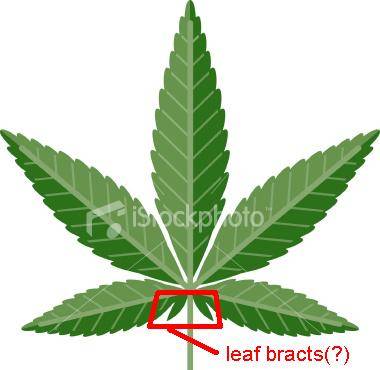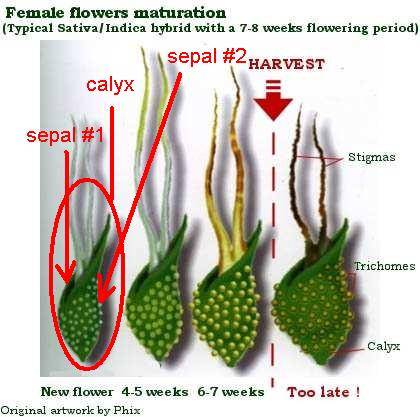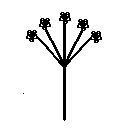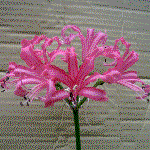Hello,
It seems there is a good bit of confusion (or at least disagreement) about usage of “bract” vs ”calyx” (re a collection of “sepals”), with respect to the flowering tissue (inflorescence) of female cannabis plants vs. non-flowering stage of growth [1,2,3]. It's not uncommon for growers [4], and even highly respected cannabis researchers (such as P.G., Mahlburg and T., Hemphill, et al. [5]), to use the term “bract” when referring to a collection of (flowering tissue) “sepals”, enclosing the ovule [6,7]. However, many other academic resources [8,9,10,11,12], incl. academics in the cannabis world (ex., R.C.Clarke [13]), refer to the collection of (inflorescence) sepals as calyx.
I use of the term "calyx" when referring to a collection of sepals. Below I edited the pics (text and lines in red), I edited to what I believe is correct, AFAIU. What do others here use, "bract" or "calyx", and why?
(all the red lines and text are my edits)
[1]

[2]

[3] (leaf "stipules", sometimes called bracts)

[4] “Marijuana female flower: calyx or bract?”
By George Grass (2003)
http://www.marioptics.webs.com/calyx.html
[5]
[6]

[7]

[8] http://www.botany.hawaii.edu/faculty/carr/api.htm

[9] http://waynesword.palomar.edu/terminf2.htm
[10] http://extension.oregonstate.edu/mg/botany/flowers.html
[11] http://extension.oregonstate.edu/mg/botany/leaves2.html
[12] http://www.cals.ncsu.edu/plantbiology/ncsc/Spring_flora/glossary.htm
[13] "Marijuana Botany: Propagation and Breeding of Distinctive Cannabis"
By Robert Connell Clarke
Ronin Publishing, 1993
ISBN 091417178X, 9780914171782
p. 161
It seems there is a good bit of confusion (or at least disagreement) about usage of “bract” vs ”calyx” (re a collection of “sepals”), with respect to the flowering tissue (inflorescence) of female cannabis plants vs. non-flowering stage of growth [1,2,3]. It's not uncommon for growers [4], and even highly respected cannabis researchers (such as P.G., Mahlburg and T., Hemphill, et al. [5]), to use the term “bract” when referring to a collection of (flowering tissue) “sepals”, enclosing the ovule [6,7]. However, many other academic resources [8,9,10,11,12], incl. academics in the cannabis world (ex., R.C.Clarke [13]), refer to the collection of (inflorescence) sepals as calyx.
I use of the term "calyx" when referring to a collection of sepals. Below I edited the pics (text and lines in red), I edited to what I believe is correct, AFAIU. What do others here use, "bract" or "calyx", and why?

(all the red lines and text are my edits)
[1]
[3] (leaf "stipules", sometimes called bracts)
[4] “Marijuana female flower: calyx or bract?”
By George Grass (2003)
http://www.marioptics.webs.com/calyx.html
[5]
- Turner, J., J. Hemphill, and P. G. Mahlberg. 1981. Interrelationships of glandular trichomes and cannabinoid content. I: Developing pistillate bracts of Cannabis sativa L. (Cannabaceae). Bull. on Narc. 33:59-69.
- Hemphill, J., J. Turner, and P. G. Mahlberg. 1980. Cannabinoid content of individual plant organs from different geographical strains of Cannabis sativa L. (Cannabaceae). Jour. Nat. Prod. 43:112-122.
- Turner, J., J. Hemphill, and P. G. Mahlberg. 1980. Trichomes and cannabinoid content in developing leaves and bracts of Cannabis sativa L. (Cannabaceae). Amer. J. Bot. 67:1397 1406.
[6]
[7]
[8] http://www.botany.hawaii.edu/faculty/carr/api.htm
[9] http://waynesword.palomar.edu/terminf2.htm
[10] http://extension.oregonstate.edu/mg/botany/flowers.html
[11] http://extension.oregonstate.edu/mg/botany/leaves2.html
[12] http://www.cals.ncsu.edu/plantbiology/ncsc/Spring_flora/glossary.htm
[13] "Marijuana Botany: Propagation and Breeding of Distinctive Cannabis"
By Robert Connell Clarke
Ronin Publishing, 1993
ISBN 091417178X, 9780914171782
p. 161
At this point the terminolog of bract and calyx should be clarified. A review of the literature shows that much confusion exists around the nomenclature of the bracts on a cannabis plant. The term bract most commonly refers to the membranous sheath surrounding the ovule which is herein referred to as the pistillate calyx or calyx. Bract is sometimes used to describe the stipule (leaf spur) which appears on both sides of the axis of the petiole (leaf stalk) with the stem. The term has also been used to describe the small reduced leaf that subtends each pair of calyxes. It is my contention that the word calyx should be used to describes the five part carpel structure of the staminate flower, or the five part fused tubular sheath that surrounds the ovule and pistils.
The word bract is preferably acceptable for the small reduced leaf subtending a pair of pistillate calyxes, and stipule is the correct term for the leaf spur. Calyx implies that the flower part is reproductive in nature, and bract has a distinctly vegetative connotation. It is unfortunate that bract has been so misused as it is really an excellent descriptive word for a small reduced leaf.To quote from Roget’s Thesaurus: “Bract, bractlet – foliage, foliation, leafage, stalk, leafstalk, petiole,… stipule,… leaf,… leaflet, blade,.. lamina,… seedleaf …calyx leaf.
Calyx – sac ….pocket…. vescule…pericarp ….capsule…pod…”
It seems obvious that bract describes leaf structure and calyx describes floural structure.





